Menu
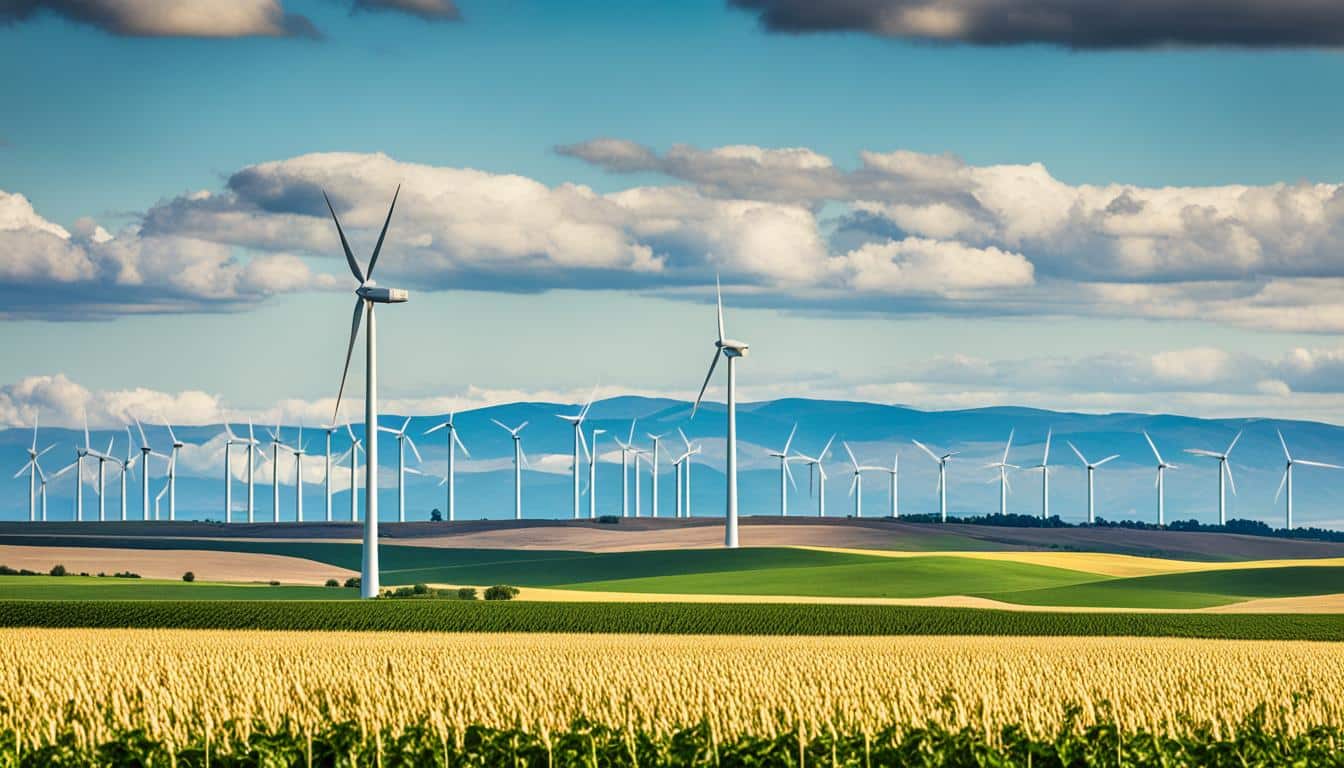
Did you know, wind power supplies more than 10% of the total U.S. electricity? It’s installed in all 50 states. We’re moving towards sustainable energy solutions, making wind power vital in farming. It boosts farm productivity in an eco-friendly way. To work well, wind plants must be placed carefully. Small turbines need about 9 miles per hour to run. They work best on hilltops, open plains, or places where the wind is channelled by mountains.
In 2022, California, Texas, Iowa, Oklahoma, Kansas, and Illinois led in wind electricity. They used their great wind conditions well. Also, offshore wind power along the Eastern coast is growing. Countries like China and the U.S. are at the forefront of wind energy. They show how wind power can change farming for the better.
Renewable energy farming is gaining ground fast for boosting sustainability in agriculture. Wind power is a top choice because of its high potential and broad use on farms.
Wind energy turns the wind’s kinetic energy into electricity via wind turbines. A generator on top of a tower spins with wind and converts the energy. This powers things like irrigation systems on farms.
A single 2.8-megawatt (MW) wind turbine can power around 100,000 homes in the U.S. This shows how much electricity these turbines can make.
Using wind energy in agriculture offers a continual clean power source, helping the environment. Wind power doesn’t pollute the earth’s atmospheres, waters, or lands with greenhouse gases.
Wind turbines fit almost anywhere, even remote areas and islands. They help cut local utility costs and open job doors. Also, they vary in size, from home-sized to big farm or industrial systems, showing wind’s flexibility.
The U.S. Department of Energy strongly supports wind power advancements. Their efforts boost both onshore and offshore wind turbines. This work is crucial for keeping wind power safe and secure against cyber threats.
I believe wind power is a great choice for farmers. It offers both economic benefits and supports a greener planet. By investing in wind projects, farmers can create local jobs and see their communities grow. Importantly, it’s a cost-effective way to power farms, making them more energy-efficient.
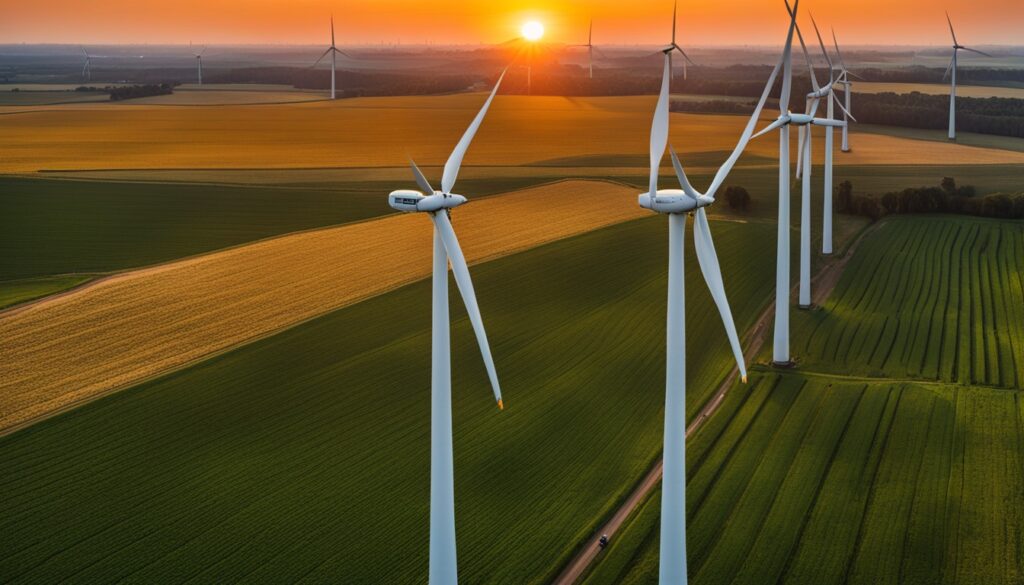
Farmers such as Chuck Goodman are making good money from wind power. He makes about $6,000 each year from three wind turbines on just 1.3 acres. In Pennsylvania, Donald and Irene Decker are also doing well with four 200-foot-tall wind turbines on their land.
The cost of producing wind power has dropped significantly since 1980. In fact, it’s now often cheaper than traditional electricity. This means farmers can improve their energy use and save money at the same time.
Wind turbines don’t take up much space, so farming activities can continue around them. This means farmers can still grow crops and raise animals on most of their land. Also, farmers often get paid for having wind turbines on their land, either through fixed leases or a share of the profits.
Beyond the money, wind power is very good for the environment. It produces no emissions, which helps to clean up the air. This is important for reducing the impact of farming on our planet.
Research has shown that wind farms can decrease extreme hot days by around 2-3% during the growing season. This can help crops grow better by avoiding very hot weather. Also, farmers with wind turbines tend to invest more in their farms’ sustainability than those without.
| Farmer | Annual Earnings from Wind Turbines | Turbine Details |
|---|---|---|
| Chuck Goodman | $6,000 | Three turbines on 1.3 acres |
| Donald and Irene Decker | Undisclosed | Four 200-foot-tall turbines |
Wind turbine technology is changing farming for the better, offering a green way to bring power to farms. It makes farming more sustainable. Now, wind turbines in France’s Marne Region can bring in around 5,000 € a year for each farm.
Wind turbine designs are getting better thanks to research. They focus on using better materials, being easy to recycle, and making less noise. Companies, like Siemens, have created blades known as DinoTailes® that help both the planet and animals. This shows a real effort to protect the environment. Laws in France push for more use of renewable energy too.
Getting communities involved is key for wind energy to work. In France, talking to the public helps get their support. The US has also seen success with deals that benefit communities. Making sure these wind projects help locals supports their growth and the use of green energy in agriculture.
| Country | Incentive Type | Details |
|---|---|---|
| France | Annual Earnings | 5,000 € per year for each wind turbine |
| United States | Production Tax Credit (PTC) | Significant federal incentive for wind energy |
The growth in wind turbine technology means a brighter, cleaner future for farming. It brings in new, earth-friendly methods.
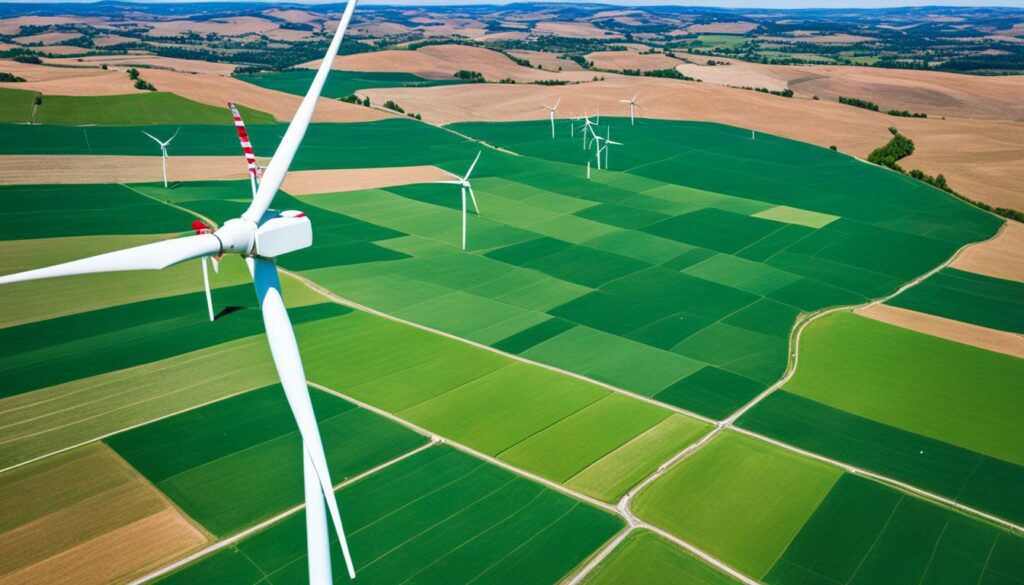
Finding the right spots for wind turbines in farming areas is key for success. Various factors must be looked at to make sure these energy solutions work well. We will explore these factors and talk about some good examples of using wind power in agriculture.
When picking locations for wind turbines on farms, key factors come into play:
| Factor | Impact |
|---|---|
| Wind Speeds | More wind means more power, which is vital for farms to work effectively. |
| Land Topography | Good land shapes can boost wind, helping turbines work better. |
| Electrical Grid Proximity | Being near electrical grids reduces power loss, ensuring energy goes where it’s needed. |
| Environmental Impact | Safety checks protect the environment, supporting the use of sustainable practices. |
Many case studies have shown wind energy’s success on farms:
In California, turbines have been placed well to meet changing electricity needs through the year. Matching turbine placement with natural wind patterns significantly boosts efficiency. In Montana, careful planning of turbine locations in windy spots has shown great success. This proves that choosing the right locations is crucial for wind power to thrive in agriculture.
Germany’s Renewable Energy Sources Act (EEG) has set a great example for encouraging renewable energy use with special rates. Research by Schreiber and others in 2019 found that placing turbines at greater heights is better for the environment. This supports the idea that smart wind turbine locations are key for their success on farms.
Using wind power on farms boosts energy efficiency and cuts costs. Wind energy lets farmers lower their bills and make money selling extra power. With wind turbines taking little space, almost all land can still be used for farming.
Wind power does not disturb farming while providing a cheap energy source. New turbine designs, such as Siemens’ DinoTailes®, are efficient and good for birds. Also, upright wind turbines suit farm areas well.
Today’s wind turbines track their own performance, so farmers don’t need to check them often. This reduces upkeep costs, good for places like Marne, France, with many people. There, farmers can make around 5,000 € a year from each turbine, helped by government support.
Wind energy has cut its costs by 90% since 1980, becoming a key affordable energy source. It helps both farmers and nature. For such projects, talks with the local community are a must, like in France and some U.S. states.
Wind power’s success stories include Chuck Goodman in Iowa, earning $6,000 yearly from his turbines. In Pennsylvania, Donald and Irene Decker see the benefits of large turbines on their farm. These cases highlight wind energy’s role in modern farming.

Adding wind power to farms faces challenges in renewable energy farming. These include high initial costs and specific wind turbine effects on the environment. Yet, we can overcome these with the right approaches and new technology.
Setting up wind power often needs a lot of money. This can be tough, but technology is making it cheaper. Thanks to about $20 billion in 2022, setting up new wind projects is proving to be a good investment. This shows the industry is growing strong.
Thanks to efforts by utilities and investors, building and running wind farms is getting cheaper. Wind energy is now more affordable than gas, geothermal, coal, or nuclear power options. Also, refitting the nation’s power grid can make expanding wind energy easier and cheaper.
Wind turbines can be loud and change the look of the area. Placing them in the best spots can limit their effect on nature and people. Better turbine designs are also helping to lessen the impact and make them more eco-friendly.
Wind farms in the U.S. cut down on 336 million tonnes of CO2 every year. That’s like taking 73 million cars off the road. This proves that wind energy is a key player in fighting climate change. But, we must keep improving how we build and run turbines to protect the environment and communities.
| Year | U.S. Wind Industry Employment | Wind Energy Generated (% of Total Energy) | Carbon Dioxide Emissions Avoided (Metric Tons) |
|---|---|---|---|
| 2022 | 125,000 | 10% | 336 million |
| 2030 (Projected) | 200,000 | 20% | 500 million |
By using these solutions and always looking for better ways to do things, we can add more wind energy to farms. This will help with money and protect the environment too.
The march of tailored wind energy solutions for farms has changed the game. These changes help farms save energy and follow green agricultural methods. By meeting each farm’s needs, they boost renewable energy farming.
Wind turbines need less space than you think. With less than half an acre each, they leave most of the land ready for crops or animals. This shows that tailored wind energy solutions fit right in without big changes. They’re placed especially where crops like wheat and maize are grown a lot in the USA.
Studying shows renewable energy farming can help crops grow better. Wind farms have lifted soybean and corn yields by 1.3% and 2.4% with more wind power. They also lower extremely hot or cold days during the growing time, helping crops.
In the Great Plains and Midwest, farmers can really benefit from green agricultural methods using wind power. Farming with wind turbines often means doubling the investment in the farm. There’s also a wide choice of turbines to meet any farm’s energy needs.
| Solution Type | Specifications | Benefits |
|---|---|---|
| Monocrystalline Panels | High Efficiency, Space Efficient | Maximise energy production in limited space |
| Polycrystalline Panels | Lower Efficiency, Cost-Effective | Ideal for reducing upfront costs |
| Thin-Film Panels | Lightweight, Flexible | Suitable for non-traditional installations |
| Bifacial Panels | Capture sunlight from both sides | Enhanced energy production |
| Eocycle S-Series Turbines | 25 to 60 kW | Small to medium-scale projects |
| Eocycle M-Series Turbines | Up to 1 MW | Medium to large-scale projects |
Wind solutions cater to both small and big farm energy needs. They offer options from small to grid-sized turbines. This means wind power is a good fit for any farm’s energy and land layout.
Creating a sustainable future needs us to mix different renewable energy sources. One powerful method is using hybrid systems. These systems add wind turbines to technologies like solar panels. This mix boosts energy output and makes it more reliable.
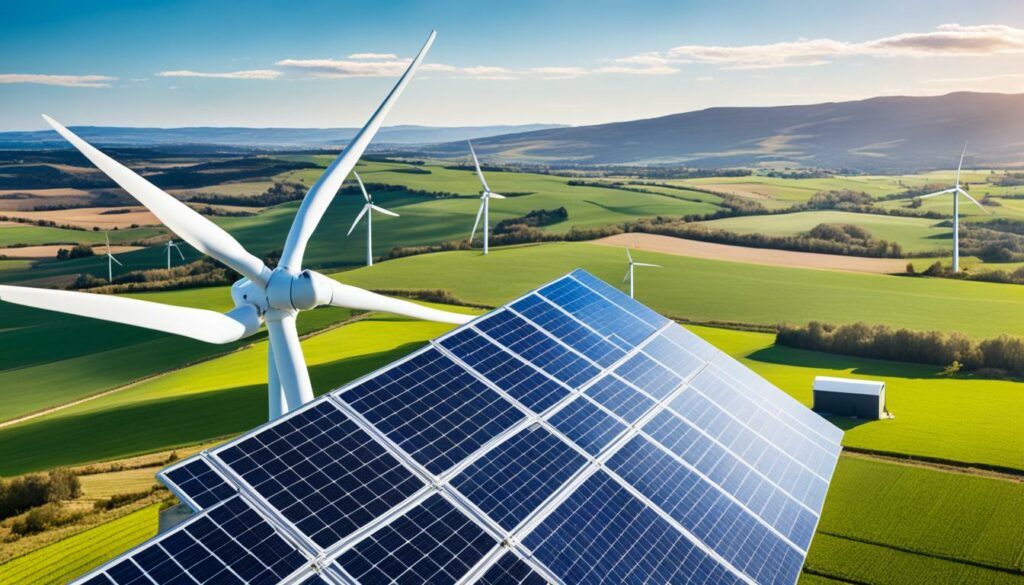
Hybrid systems combine different renewable energy sources. Wind turbines produce lots of power on windy days. Solar panels then offer energy when the sun shines. Together, they ensure a constant energy supply, ideal for farms.
Putting together renewable sources has many pluses. It makes energy use more efficient and lowers the risk of power cuts. It can also save money over time, by cutting energy bills and even earning money by selling extra power.
These systems are great for the environment too. They cut down on greenhouse gases, making farming more sustainable. By using less fossil fuels, they help create a greener landscape.
| Benefit | Detail |
|---|---|
| Enhanced Efficiency | Combines multiple sources for consistent energy output |
| Economic Savings | Potential to cut costs and generate additional income |
| Environmental Impact | Reduces fossil fuel use and greenhouse gas emissions |
| Reliability | Decreases energy supply disruptions |
By using wind and other renewable systems, farming can change a lot. These renewable systems keep farms going, while making the future greener and stronger.
Many governments are encouraging the use of wind energy on farms. They offer farmers money to help pay for wind turbines. This money helps farming not only by being good for the planet but also because it saves farmers cash.
The US government’s REAP programme gives farmers money for renewable energy projects. It can pay for up to 75% of the costs. You could get between $2,500 and $1 million for your project.
Through REAP, The Inflation Reduction Act has given over $144 million for farm tech. This includes funds for projects that don’t get much attention.
The Department of Energy (DOE) is also helping with $4 million. Of that, $2.5 million goes just for farmers. This money is used for testing and making wind energy tech better. And $1.5 million helps farmers find new ways to use this tech.
The tax breaks for wind power are very attractive. They cut down the cost for farmers. For example, farmers get a tax credit for each kWh their windmills produce.
This means farmers can plant crops close to wind turbines and produce clean electricity. This is great for their wallets and the environment. Chuck Goodman makes around $6,000 a year this way. Programmes like REAP help a lot by supporting financial needs and greener farming.
But, it’s not just about the money. Along with cash, help is also given for checking if projects are good for nature. And for making sure locals like the project too. This helps new wind projects to help the community and the land around them.
| Incentive | Details | Funding Range |
|---|---|---|
| REAP Grants | Grants for renewable energy systems | $2,500 – $1 million |
| Energy Efficiency Grants | Grants for energy efficiency improvements | $1,500 – $500,000 |
| Loan Guarantees | Covering up to 75% of project costs | Varies |
| DOE Funds | Distributed wind technology development | $4 million total |
| Tax Benefits | Depreciation and tax credits | Varies |
I love sustainable wind energy and all the new ways it’s changing agriculture. New tech makes wind turbines better for the environment, quieter, and safer for wildlife. Companies like Siemens are making turbine blades that work well but don’t make a lot of noise.
In the Marne Region of France, where there aren’t many people, wind farms are a big success. For each wind turbine, farmers can make about 5,000 € every year. This shows how valuable wind energy can be for farmers.

In the United States, wind projects get help from the government, like the Production Tax Credit (PTC). Although Congress needs to keep renewing these helps, they are very important. Also, local state grants and tax breaks can help farmers start up. Remember, the rules for where you can build wind farms change from place to place, so it’s important to check.
Now, wind turbines come with high-tech to check how they’re doing all the time. By 2035, they’re going to get even better, with bigger blades and taller towers. This overhaul will make wind power more useful and affordable for farms.
By 2050, the wind industry could need more than 6 million workers to keep the turbines running. Just last year, wind power grew by a lot, showing it has a bright future. This not only helps the planet but creates many jobs too.
Mixing wind with solar power means even more reliable energy. This connection can help us reach global goals for the environment. It will reduce our need for things like oil and gas.
| Region | Population Density | Annual Earnings per Turbine |
|---|---|---|
| Marne, France | 70 inhabitants/km² | 5,000 € |
| United States (Examples) | Varies by state | Depends on state incentives |
To start using wind power on your farm, first, check the wind. You need to know if your place has enough wind for turbines. Some states offer anemometer loan programs to help with this. They check if your site gets the right amount of wind each year.
Looking into the wind is key. But, you also need to understand the rules in your area. There might be specific zones or areas where you can’t put wind turbines. Experts can guide you on the best spots for your turbines, and help handle any local rules.
Getting help to pay for it is a big step. The government gives a 30% tax break on small wind systems. Also, there are other financial aids available. These can make the start-up costs much lower, making it easier to get into wind power.
Before putting up turbines, look at how they might affect the power grid. This is to make sure they won’t cause problems for others using the same grid. It’s an important part of setting up wind power safely and effectively on your farm.
It’s also important that your community is okay with your wind turbines. Talk to local people and have meetings to explain your plans. Make efforts to be friendly to the environment, like finding ways to protect birds and bats. This can make your community more likely to support your wind energy efforts.
Wind energy is making a big impact in fields and farms. For instance, in a year, wind projects add more than $1.6 billion to local areas and in rent to the owners. Take O’Brien County, Iowa. Since 2016, its three wind farms have produced over 500 MW of energy. This brought not just energy but also jobs and boosted community life.
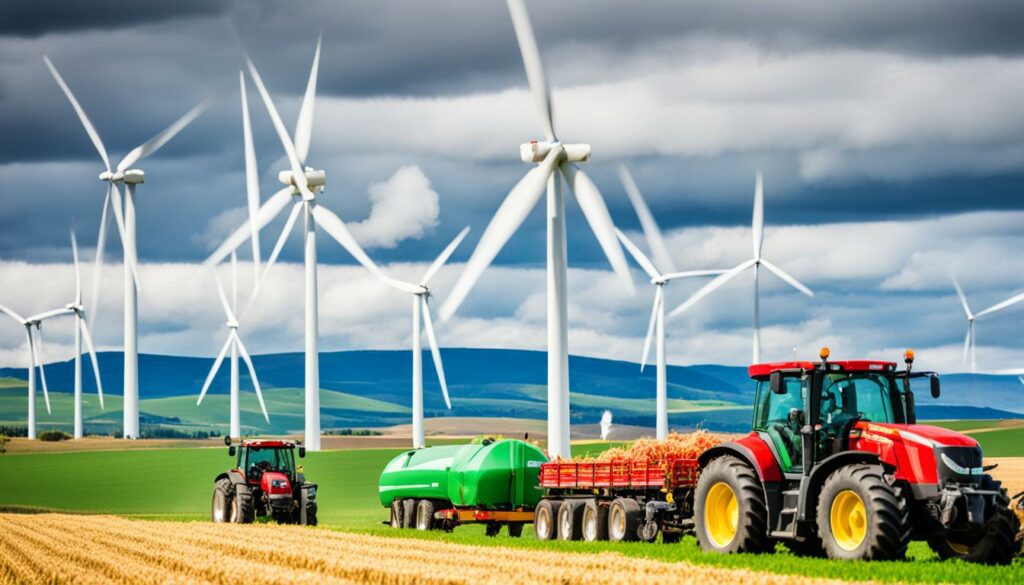
In Logan County, Illinois, the wind energy story is just as impressive. They have three wind farms working, and one more is being built. Local people have seen more money for their area and better services. The Hill Topper wind farm gave $110,000 for local projects, helping start a food coop and fix old buildings.
In Ford/Livingston County, Illinois, wind farms made over $2 million in their first year. It’s said they will make over $3 million in all. This kind of money is really important for rural areas. It shows how wind power helps farming communities a lot.
Glaciers Edge wind farm in Cherokee County, Iowa does more than make clean energy. It also made 25 new jobs and pays $1.5 million in tax every year. These numbers prove that wind farms help both the economy and the planet in the countryside.
Below, there’s a table with key points on how wind energy is helping. It sums up their contributions neatly.
| Location | Key Achievements | Economic Impact |
|---|---|---|
| O’Brien County, Iowa | 3 wind farms, 500 MW since 2016 | Enhanced community financial health |
| Logan County, Illinois | 3 wind farms operational, 1 under construction | $110,000 for local development |
| Ford/Livingston County, Illinois | First-year revenue over $2 million | Projected lifetime revenue over $3 million |
| Cherokee County, Iowa | Glaciers Edge wind farm | 25 new jobs, $1.5 million in annual tax payments |
The stories about wind power are very positive. They not only highlight the economic benefit but also other good things. These achievements can be examples for others to follow. Wind power is changing the way we farm, bringing big advantages for the economy and the environment.
Using wind power in farming is a big step towards using clean energy. Its cost has come down a lot since 1980, making it a great choice for farmers. By 2010, making electricity from new wind projects was expected to be cheaper than from old power plants.
Today, wind turbines are in all states in the U.S. They give more than 10% of the country’s electricity. Places like Texas, Iowa, and Oklahoma are using wind power well. A single wind turbine can power up to 100,000 homes. Plus, they don’t take up too much space, so farming can carry on around them.
Farmers are getting creative, using wind power in smart ways. Some use it to run water systems, cutting costs and using less oil. Dairy farms use it to have a reliable energy source. There are many ways for farmers to make money from wind energy.
Smaller wind turbines can be placed close to where they’re needed, like homes or farm operations. They come in sizes suitable for various needs. This makes wind power a great fit for many farms, cutting energy costs and reducing the bills.
Wind power in farming means using wind turbines to make electricity. This green energy source benefits the environment. It also aids farmers in their work without harming the planet.
Wind energy cuts down on electricity costs for farmers. It also lets them sell extra energy for profit. This boosts the local economy and creates new jobs in the renewable energy sector.
Wind energy is green because it doesn’t emit harmful substances. This helps farming cut down on carbon and its impact on the environment. It’s a big win for our planet.
Choosing the right wind turbine spot is key. Look at how fast the wind is and the lay of the land. Being near power lines is also important. Ideal spots are high and wide spaces where the wind is strong.
Places like California and Montana in the US show how well wind power can work for farms. They match the times the farms need most electricity. This makes the wind turbines much more effective.
Wind turbines use the wind’s power to make electricity. They have blades on a tall pole. The electricity can then run many farm activities, like watering crops. This means farms can be more eco-friendly.
Starting with wind power can be expensive and has environmental concerns. To tackle this, farmers can get help from the government with money and advice. They should also check on how it affects local animals.
Hybrid systems use both wind and solar power. They are more reliable because they balance each other out. This means farms can have power more consistently, helping everything run smoothly.
The government offers help like money, grants, and tax breaks for wind projects. These benefits make it easier for farmers to choose renewable power. It’s a way to support farmers going green.
The outlook for wind power on farms is good. As technology gets better, it becomes more affordable and versatile. This supports the future of sustainable farming.
First, farmers need to check the local wind and laws. Then, they should get advice on where to put wind turbines and find out about funding. Don’t forget to look into how it affects the power grid and get the right permissions.
From California and Montana to other places, many farms have shown success with wind power. These stories highlight the good it does for business and nature. They inspire more farmers to try it.
Wind energy is used in many smart ways on farms. It powers things like watering systems and dairy farms. These uses show how adaptable and helpful wind energy is in farming.